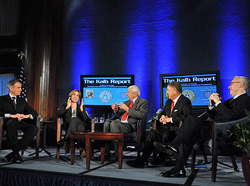|
April/May 2009
News Executives Discuss Future of Journalism on Kalb Report
 |
Four top media executives—Associated Press’ Tom Curley, CNN’s Jon Klein, NPR’s Vivian Schiller and Alberto Ibarguen, president and chief executive
officer of the John S. and James L. Knight Foundation—joined Marvin Kalb March 23. |
By Julia Parmley
Four top media executives
discussed the future of
journalism and innovations
in news reporting with
Marvin Kalb in front of a
capacity crowd of GW students and other guests at the
National Press Club March 23. “Down to the Wire: Journalism
in Crisis”—featuring
Tom Curley, president and
chief executive officer of the
Associated Press; Jon Klein,
president of CNN/U.S.;
Vivian Schiller, president and
chief executive officer of
NPR; and Alberto Ibarguen,
president and chief executive
officer of the John S. and
James L. Knight Foundation
and former publisher of The
Miami Herald and of El
Nuevo Herald—was the last
installment of the 2008-09
series focused on democracy
and the press.
In the face of massive
newsroom layoffs and bankrupt
newspapers, the panelists
agreed that generating
revenue was a tremendous
concern for news companies.
Ibarguen said adapting the
way information is packaged
and delivered, including utilizing
new media tools, will
be critical in keeping and
attracting consumers.
“I think the bigger conceptual
issue, and the one that’s
very, very hard if you come
from a traditional media…is
the psychological shift of a
news consumer to a news
user,” said Ibarguen, who
received an honorary doctorate
from GW in 2005. “The
consumer now is the user of
information. I think the next
generation expects…to either
participate in the information
or the discussion of it and
use it in some interactive way.”
With the myriad ways to
receive news “on the go,” the
panelists discussed how sensationalism
and inaccurate
reporting can run rampant
and the potential loss of
investigative reporting in
print. Schiller said news outlets
need to trust their audience.
“I actually think that
most of the listening, viewing
and using audience is pretty
good at discerning clutter
from real stuff and they will
self select,” she said.
Curley expressed his belief
that there will still be a place
for newspapers in the industry. “I do believe [newspapers]
will be doing at least as much
investigative or context
reporting as they do now,
and probably more because
some of the breaking news
function might go elsewhere,
to BlackBerry devices and
mobile devices and other
ways that news gets covered,”
said Curley. “But there will be
other, new players, new
entrants. There will be more
free newspapers, and many
of them may be targeted at
things such as entertainment
but also around issues.”
Klein said the demand for
news is still strong and urged
aspiring journalism students
not to lose hope. “The world
is changing. There are many
other ways evolving for
humans to practice journalism,”
said Klein. “And there
are still going to be people
who are just dying to get out
there and talk about and find
out about what’s going on
in their communities, and
they’re going to have more
tools at their disposal.”
The Kalb Report is
produced by the GW
Global Media Institute in
partnership with Harvard
University’s Shorenstein
Center, and the National
Press Club and is under-
written by a grant from the
Ethics and Excellence in
Journalism Foundation.
For more information, visit
globalmedia.gwu.edu or
call 202-994-6463.
Send feedback to: bygeorge@gwu.edu |

